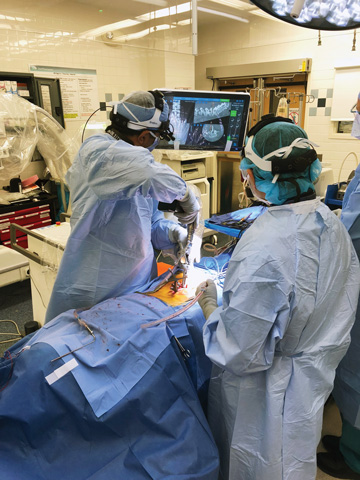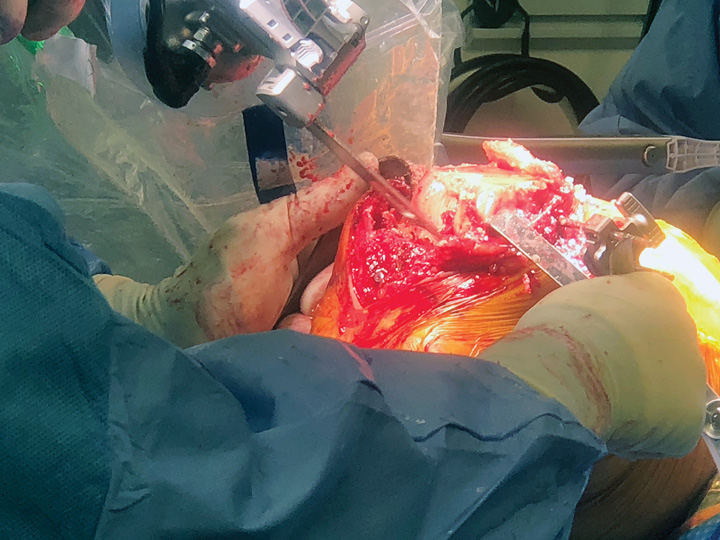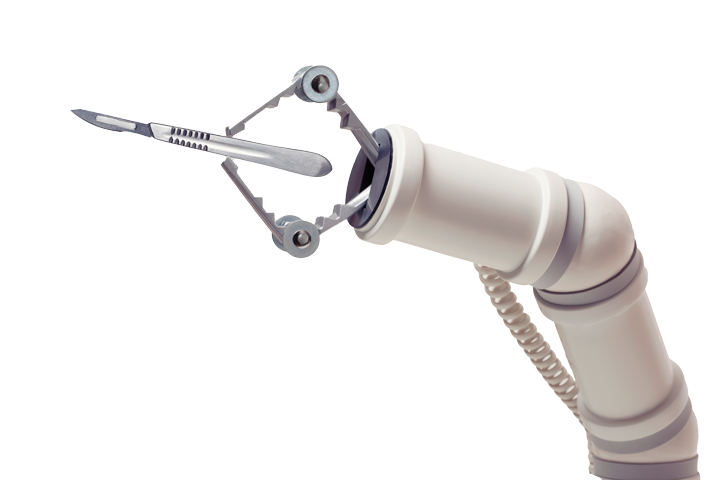- Home
- Article
Are Robotic Platforms More Attainable Than Ever?
By: Matthew Nojiri | Contributing Editor
Published: 4/1/2024
Precise incisions, clearer fields of view and competition are driving the high-tech trend in ambulatory settings.
The potential and appeal of robotic platforms has always been easily understood: Surgeons gain clearer fields of view (in three-dimensions) on devices that are unhindered by hand tremors or the limits of human dexterity.
Translating that potential and appeal into working ORs, however, is not so easily understood. “On the medical side, development of technology is one piece of the pie. Adoption is another,” says Raymond J. Lanzafame, MD, MBA, FACS, executive director and chairman of the Society of Laparoscopic & Robotic Surgeons, and a longtime advocate for technology-assisted, minimally invasive approaches to patient care.
Adoption of robotics in outpatient surgery appears to be ramping up, but to what end? “The question,” asks Dr. Lanzafame, “is where is all of this going?”
The economics of robotics
Since the early 2000s, advances in robotic surgery have made headlines, but the seven-figure sticker shock has proven a significant obstacle, particularly outside of hospitals. Payors do not provide additional reimbursement for robotic surgeries, so clinical teams and administrative leaders must make a strong case to bring the tech into their ORs.
Times, however, are changing. As patents held by Intuitive Surgical, the pioneer in surgical robotics that has dominated the market for decades, have expired over the last few years, multiple startup companies have entered the market. Competitors are trying to pave the way for smaller ASCs to gain access to less expensive robots tailored to their facilities.
At the same time, a new generation of surgeons are training on robotic platforms, while patients are demanding shorter recovery times. In crowded regions with several options for ambulatory surgery, robotics offer marketing sizzle for facilities looking to gain an edge in attracting both patients and surgeons. “The available technique and technology drives people to your doorstep,” says Dr. Lanzafame. Competitive markets are spurring innovation and investment in care. Urologists, orthopedists and other surgical specialists are training in tech-forward, hybrid ORs from the beginnings of their careers. By investing in technology, outpatient facilities can better compete for the next generation of surgeons coming out of residency programs who expect to work in ORs that house the latest innovations.
“Competition drives what the offerings are going to be. If you are in a very highly competitive market, robotics might drive patient volume to your ASC, being on the cutting edge of technology,” says Raghu Reddy, chief administrative officer of SurgCenter of Western Maryland in Cumberland.
Cost-benefit is key

Vendors now offer incentives to mitigate the significant capital expenditure required to acquire a surgical robot, including longer-term payment plans. Some will agree to partially offset the major upfront cost of a robot by contracting with the surgical facility for their implants and disposables. “If you are able to keep some of the margin on the volume (of cases), it’s more doable,” notes Mr. Reddy. “It all depends on how a center views the robot. For some people, it’s a must-have. For others, it’s a nice-to-have. Some will wait to see if the payors will go for it.”
Mr. Reddy says performing a cost-benefit analysis is crucial to ensure the financial numbers work for your facility. The analysis should take into account case volumes, the local competitive landscape and the needs of clinical staff, among other factors. Mr. Reddy says that, in the orthopedics space, these factors must be collectively stabilized before robotics can become the standard of care for joint replacement.
Top trends
The potential benefits of robotics in surgery are well-known: more precise movements, a clearer 3D field of view and full range of motion. Advocates of surgical robotics say these attributes support improved outcomes, particularly in terms of reducing pain, blood loss, recovery times and scarring.
Dr. Lanzafame says robotics can support surgeons of wide ranges of skill and experience levels. For instance, it can improve the efficiency of veteran surgeons, while shortening learning curves for newer surgeons in the field. While any new technology requires time to master, he believes it’s worth the trouble with robotics.
Dr. Lanzafame recalls a story from years ago when a surgical team gathered for training on a robotic platform. With some coaching and guidance, a surgical tech in her early 20s successfully removed a pig’s gallbladder with ease during the exercise. “Right out of the gate, she was able to do a cholecystectomy with a robot in a lab better than 90 percent of my colleagues,” he remembers. “It’s very powerful, very enabling technology.”
The next frontier

Full-scale adoption of surgical robotics will ultimately hinge on payor enthusiasm to fund it. Insurers want definitive data that highlights improved outcomes with fewer complications before facilities will see progress in their billing codes. It will take more time, however, for the data to catch up with the many anecdotes from patients and providers about improved recovery times, more precise incisions and increased efficiency in the OR. “Those benefits are of intrinsic value,” says Mr. Reddy. “But whether that value is worth the cost is still to be decided. While the technology itself has matured, the data is still in the early stages.”
Dr. Lanzafame agrees that full-scale adoption of robotics will take time, as surgical teams must carefully weigh the technology’s potential benefits against the cold realities of the cost of care.
“The gorilla in the room is the economics,” he says. “It will be a long time until the economics catch up with the engineering and the science.” Medicare and commercial payors are another vital piece of the robotics puzzle. “If we want to progress as a country on the cutting edge of technology, the money is going to have to come from somewhere,” says Mr. Reddy.
Here to stay
The bottom line, however, is that although wide adoption of robotic surgery may take some time, the principles driving the trend are crystal clear and legitimate. “We’re heading toward more use of and dependence on technology,” says Dr. Lanzafame. “The fusion of technology and minimally invasive virtues is here to stay.” OSM

Over the past two decades, robotics have become increasingly prevalent across a host of different service lines in U.S. ORs. Here are five key considerations if you are interested in getting started in this emerging field.
• In the OR. Every surgical team is equipped with a different set of skills and personalities. Is there an appetite and culture present to incorporate more tech-focused approaches into your team’s workflow?
• Financing. To address “sticker shock,” a growing number of manufacturers are offering alternative financing approaches for robotic devices. These could include extending the timeline for repayment or providing purchasing agreements for implants and other disposables to reduce the upfront costs for the robotic system.
• Research-driven. Clinical teams and administrative leaders do not take capital investments lightly. When investigating the viability of robotics at your facility, search for evidence-based research and consider the latest care trends to determine if there is justification for making the investment.
• Cost-benefit analysis. The potential for shorter recovery times, more precise incisions and imaging, and tremor-free procedures must be balanced against the upfront costs for robotic platforms. A careful review of your balance sheet is crucial before making the plunge.
• Competition spurs technology. In competitive markets, technology can be a strong selling point to attract patients and the next generation of surgical leaders who have been trained on high-tech platforms.
—Matthew Nojiri
.svg?sfvrsn=be606e78_3)
.svg?sfvrsn=56b2f850_5)